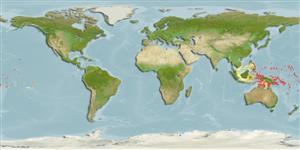Common names from other countries
>
Ovalentaria/misc (Various families in series Ovalentaria) >
Pomacentridae (Damselfishes) > Pomacentrinae
Etymology: Amphiprion: Greek, amphi = on both sides + Greek, prion, -onos = saw (Ref. 45335).
More on author: Cuvier.
Environment: milieu / climate zone / depth range / distribution range
Ecología
marino asociado a arrecife; no migratorio; rango de profundidad 0 - 40 m (Ref. 89972). Tropical; 15°N - 15°S
Pacific Ocean: Queensland, Australia and New Guinea to the Marshall and Tuamoto islands.
Length at first maturity / Tamaño / Peso / Age
Maturity: Lm 7.5, range 7 - 8 cm
Max length : 17.0 cm TL macho / no sexado; (Ref. 9710)
Espinas dorsales (total): 10 - 11; Radios blandos dorsales (total): 15-17; Espinas anales 2; Radios blandos anales: 13 - 14.
Adults inhabit passages and outer reef slopes. Known to occur at 25°C. Feed chiefly on planktonic copepods, algae, echiuroid and sipunculoid worms, and pelagic tunicates. Oviparous, distinct pairing during breeding (Ref. 205). Eggs are demersal and adhere to the substrate (Ref. 205). Males guard and aerate the eggs (Ref. 205). Associated with the anemones: Entacmaea quadricolor, Heteractis aurora, Heteractis crispa, Heteractis magnifica, Stichodactyla haddoni, and Stichodactyla mertensii (Ref. 5911). Minimum depth reported taken from Ref. 128797.
Oviparous, distinct pairing during breeding (Ref. 205). Eggs are demersal and adhere to the substrate (Ref. 205). Males guard and aerate the eggs (Ref. 205). Spawning pairs can be found throughout the year. The total annual egg production is estimated at 3,000 - 5,000 eggs (Ref. 237). Fecundity ranges from 128 - 632 (Ref. 237). Also Ref. 7471, 240.
Fautin, D.G. and G.R. Allen, 1992. Field guide to anemonefishes and their host sea anemones. Western Australian Museum, Francis Street, Perth. (Ref. 5911)
IUCN Red List Status (Ref. 130435)
CITES (Ref. 128078)
Not Evaluated
Threat to humans
Harmless
Human uses
Pesquerías: pesquerías de subsistencia; Acuario: Comercial
Más información
ReferenciasAcuiculturaPerfil de acuiculturaRazasGenéticaElectrophoresesheritabilidadEnfermedadesProcesamientoMass conversion
Herramientas
Special reports
Download XML
Fuentes de Internet
Estimates based on models
Preferred temperature (Ref.
115969): 27.2 - 29, mean 28 (based on 146 cells).
Phylogenetic diversity index (Ref.
82804): PD
50 = 0.5000 [Uniqueness, from 0.5 = low to 2.0 = high].
Bayesian length-weight: a=0.02344 (0.01149 - 0.04783), b=2.99 (2.82 - 3.16), in cm Total Length, based on LWR estimates for this (Sub)family-body shape (Ref.
93245).
Nivel trófico (Ref.
69278): 2.2 ±0.0 se; based on diet studies.
Resiliencia (Ref.
120179): Alto, población duplicada en un tiempo mínimo inferior a 15 meses (tm<1; Fec=128-632).
Fishing Vulnerability (Ref.
59153): Low vulnerability (16 of 100).
